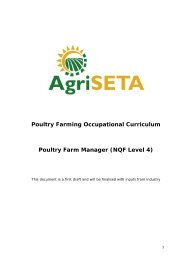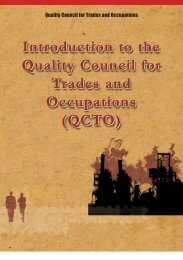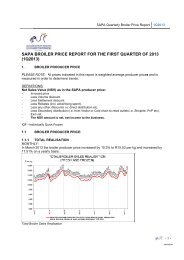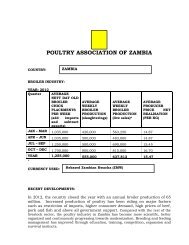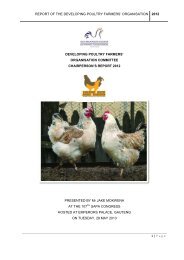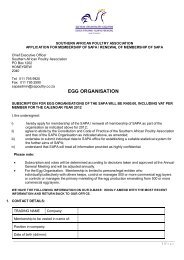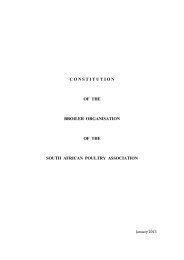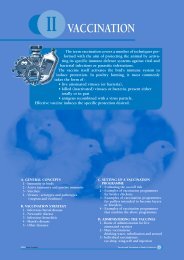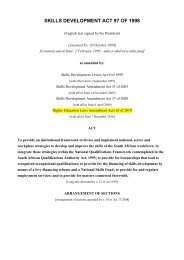Part 3 â Factors affecting vaccination
Part 3 â Factors affecting vaccination
Part 3 â Factors affecting vaccination
- No tags were found...
Create successful ePaper yourself
Turn your PDF publications into a flip-book with our unique Google optimized e-Paper software.
Vaccines-Ch3 17/05/05 11:29 Page 81IIIFACTORS AFFECTINGVACCINATIONMany factors can have a strong impact on the desired effectsof <strong>vaccination</strong>. The sanitary manager and the farmer must takeall the necessary steps to control both the practices used duringthe <strong>vaccination</strong> operation and external factors.The first group of factors are thus related to the conditions on the farm, andare based on the principle that only healthy animals should be vaccinated.The second group corresponds more directly to how the <strong>vaccination</strong> operationis actually carried out and is based on another key principle, namelythat vaccine only confers good protection if it is stored well and administeredcorrectly in accordance with a suitable programme. These various factorscomplement the technical aspects detailed previously, and relate particularlyto the spread of information on the farm, the training of employees,the material means implemented and the controls and tests carried out.These various factors should be considered with equal importance. Ineffect, failure to respect any one will compromise the overall quality of the<strong>vaccination</strong>.A. FACTORS RELATINGTO THE CONDITIONS ON THE FARM1 - Stress and <strong>vaccination</strong>2 - Mycotoxicosis and <strong>vaccination</strong>3 - Infectious diseases <strong>vaccination</strong>B. FACTORS ASSOCIATEDWITH VACCINATION1 - The vaccine factor2 - The human factor3 - The bird factorCEVA Santé Animale Vaccines and Vaccination in Poultry Production 81
Vaccines-Ch3 17/05/05 11:29 Page 823<strong>Factors</strong> <strong>affecting</strong> <strong>vaccination</strong>AFACTORS RELATING TO THE CONDITIONS ON THE FARM• 1. STRESS AND VACCINATIONStress is "the non-specific response to environmental stimulation" or more precisely, "the result of excessivedemands placed on the physiological and behavioural abilities of animals to adapt" (DANTZER, 1979).In fact, any stimulation if it is sufficientlyintense and prolonged, causes a non-specificstress reaction as well as a specific reactionwhich enables the animal to adapt to the changein the environment. In most cases, the physiologicalresponses are non-specific, whereasbehavioural responses tend to be specific.Under modern poultry rearing conditions, thebirds only have a limited range of behaviouralresponses available to them that enable themto adapt to the environment and thus to escapefrom excessive stimuli. This is the reasonwhy stress plays a greater role in more intensiveforms of production.RearingtechniqueFarmerCOMFORTZONEFeedThe bird's comfort zone is governed by inputfrom 6 inter-related factors : the farmer, thefeed, the building, the microbial flora, the animaland the rearing techniques used on thefarm. These inputs change continually duringthe animal's life. Any sudden change to thebalance of these inputs can destabilise the birdand thus generate stress.TABLE XVII :MicrobialfloraAnimalFigure 14 : The comfort zone and six factors which have an affect on itHigh-risk periods and stress factorsBuildingHIGH-RISK PERIOD STRESS FACTORSHATCHING• microbial flora(ambient or micro-organisms carried latently)• handling (sexing)START-UP• transporting• debeaking• rearing conditions (temperature, watering, etc.)• handling• vaccinating with live vaccinesGROWTH• increased bird density• microbial flora• temperature, ventilation• <strong>vaccination</strong> with live vaccinesSTART OF LAY• physiological disturbances• psychological disturbances (light programme,overcrowding, change of building, feeding, etc.)LAYING• rearing conditions, overcrowding...• <strong>vaccination</strong>82 Vaccines and Vaccination in Poultry Production CEVA Santé Animale
Vaccines-Ch3 17/05/05 11:29 Page 833<strong>Factors</strong> <strong>affecting</strong> <strong>vaccination</strong>AFACTORS RELATING TO THE CONDITIONS ON THE FARM1.1 The consequences of stressThe main consequences of the reaction to stress is the mobilisation of the organism's reserves and immunosuppression.Depending on the intensity and duration of the stress, the animal either recovers its normal stateor undergoes a decompensation phase which is characterised by the depletion of the organism's reserves,impairment of the vital organs (kidneys, heart) and suppression of the main functions (notably the immunedefence system), which can lead to the death of the animal.TABLE XVIII :Consequences of stress on production performanceDecreased consumptionDigestive disordersDecreased digestive secretions from the pancreas and of bileIncreased catabolismMobilisation of energy reservesWeight lossDecreased production of somatotropin (growth hormone)Growth retardationHeterogeneity of the grow-outDecreased calcaemiaFragile bones and eggshellsDisrupted layingRetention of the egg in the oviductFertility-related disordersInhibited production of sex hormonesPoor hatchabilityThe adverse consequences of stress on the immune defence system are, as with the disorders mentionedabove, mainly due to the effects of glucocorticosteroids.• Inhibition of the synthesis of prostaglandins and leukotrienes; mediators of inflammation which promotethe flow of leukocytes.• Imbalance in the blood cell count : leukocytosis (overall increase in the number of leukocytes), lymphopenia,eosinopenia, heterophilia.• Qualitative degradation of the leukocyte lines: phagocytosis and the production of bactericidal substancesby heterophiles and the macrophages are diminished. Equally, the activity of the T-cells (cell-mediatedimmunity) is reduced.These effects caused by corticosteroids are temporary and reversible. However, prolonged stress in youngbirds can lead to the premature regression of the lymphoid organs (thymus, bursa of Fabricius, spleen).The combination of these effects on the metabolism and immune system of stressed birds means that a <strong>vaccination</strong>given during this period will clearly not confer the protection that could otherwise be expected.Therefore, it is very important either to control the stress or to correct its effects.1.2 Controlling stressIt is easy to differentiate between predictable stress (handling, start of laying) and unpredictable stress (heatstroke, incidents during rearing, etc.)In the first case, attempts are made to control the causes of the stress and its effects in a preventive manner.However, birds subjected to unforeseen stresses should not be vaccinated until its effects have not beencompletely resolved.CEVA Santé AnimaleVaccines and Vaccination in Poultry Production83
Vaccines-Ch3 17/05/05 11:29 Page 843<strong>Factors</strong> <strong>affecting</strong> <strong>vaccination</strong>AFACTORS RELATING TO THE CONDITIONS ON THE FARMTwo approaches can be used to control stress :• the simultaneous control of the various input factors (farmer, feed, building, animal, microbial flora, rearingtechnique) and of the related sources of stress which affect the animal's quality of life. The aim istherefore the non-specific prevention of stresses, which is the tacit objective of any rational rearing programme.• implementing therapies designed to reduce the intensity of stress and/or to help the animals to cope withits consequences.In all cases, the anti-stress therapy should not be considered and used as the only means of tackling stressand its effects. On the contrary, it should, wherever possible, accompany a series of corrective hygiene-relatedand/or zootechnical measures aimed at restoring the comfort of the stressed animals. Once the sourceof the stress has been identified, this cause should be eliminated wherever possible : i.e. by reducing thebird density, increasing the number of feeders and drinkers, improving the ventilation, etc.❜ ADMINISTERING VITAMINSThe provision of vitamins to stressed animals is extremely beneficial since the reactions to all types of stressuse up vitamins either directly (e.g. vitamin C, which is required for the synthesis of glucocorticosteroids,or indirectly due to the general increase in metabolism which consumes the B-group vitamins which areinvolved in most intermediate metabolism reactions. Vitamins alleviate some of the adverse effects causedby stress (e.g. vitamins A, E, C and B which strengthen the immune defence system).How to use vitamins to combat stress :- administer 24 hours before a predictable stress, and for the entire duration of the stress.- administer via fresh drinking water, to prevent any degradation.Types of vitamin and multi-vitamin mixtures :- Vitamin C : via drinking water, dosage : 1 gram / litre of water. Use a form of vitamin C whichis stable in water.- Multi-vitamin mixtures (A, D3, E + B-group water-soluble vitamins) : "attack" doses, muchgreater than normal nutritional requirements are the most effective.TABLE XIX :The role of vitamins in overcoming stressFUNCTION VITAMIN MODE OF ACTION• synthesising glucocorticosteroids Vitamin C hydroxylation ofthe steroid hormones• stimulating metabolism B-group vitamins co-enzymes of intermediatemetabolism• protecting mucous membranes Vitamin A enables cell differentiationVitamin Eanti-oxidant• stimulating immunity B-group vitamins participates in the process ofcell differentiation and maturationVitamin Eprotects macrophages fromfree radicals84 Vaccines and Vaccination in Poultry Production CEVA Santé Animale
Vaccines-Ch3 17/05/05 11:29 Page 873<strong>Factors</strong> <strong>affecting</strong> <strong>vaccination</strong>AFACTORS RELATING TO THE CONDITIONS ON THE FARMWater and the ambient temperature are the two main parameters.The minimum humidity level that allows moulds to grow is 13.5% for cereals and 7 to 8% for oilseeds.Any temperature heterogeneity in the storage vessel (e.g. : where one side of a silo is exposed to the sunand the other side is in shade) causes water vapour to migrate to the cooler areas. A local increase in thehumidity initiates the growth of mycoflora which can then develop.However, granulating the feeds causes a significant reduction in the mycoflora, although some species resistbetter than others (Aspergillus group glaucus).The development of the moulds changes the appearance, taste and smell of the feed, in addition to its nutritivevalue. It may also lead to mycosis, allergies and mycotoxicosis as a result of the production of mycotoxinswhich contaminate the feed.2.2 The production of mycotoxinsSince all moulds are not toxinogenic, then although the growth of moulds is a necessary condition, it is notsufficient in itself to allow mycotoxins to develop.Mycotoxins may be present in the feed even when the moulds which produced them are no longer present,either due to the mycoflora evolving, or due to technological treatments (e.g. extrusion...).Mycotoxins are the secondary metabolites of the micro-organism : they are often fairly specific to the strain.Most mycotoxins induce a toxic effect and cause specific organic lesions.The conditions that allow toxins to form are more specific than those which allow the fungi to grow :• A temperature-humidity profile can be determined for each mould-mycotoxin pair which defines thehigh-risk hydro-thermal conditions to avoid.• A reduction in the partial pressure of O2 and especially an increase in the CO2 content has an inhibitingeffect on the formation of toxins.• The formation of toxins is much more dependent on the nature of the substrate than on the fungalgrowth itself. For example, the preferred ingredients for the biogenesis of aflatoxins and of ochratoxinA are, in decreasing order of preference : carbohydrates, lipids and proteins. Thus, cereals are muchmore likely to be affected by toxins than soya and proteins of animal origin.CEVA Santé AnimaleTABLE XX :Sources of the main mycotoxins responsible for mycotoxicosis in poultry farming (LE BARS, 1992)MYCOTOXIN MOULD FEED FAVOURABLE ENVIRONMENTALFACTORS• Aflatoxins Aspergillus flavus Peanuts, cotton, Wet heat :A. parasiticus sorghum, oats, 1. tropical zonesbarley, soya2. poor storage conditions• Zearalenone Fusarium spp Maize, sorghum, Alternating cold and mild weather,barleytemperate climates.• Ochratoxin A Penicillium granulatum Barley, oats, Cold and damp climates,Aspergillus ochraceus maize, wheat humidity during storage• Fumonisin B1 Fusarium moniliform Maize Wet heat• Trichothecenes Fusarium tricinctum Cereals Alternating freeze-thaw,Fusarium spp.cold climates.The post-harvesting period, especially when combined with poor storage conditions, is a particularlyfavourable time for the production of toxins and is characterised by the formation of "hot spots", i.e. zoneswithin the stored volume in which the concentration of toxins is very high.Once produced, the toxin is stable and remains in the cereal and feed even after the fungi have disappeared.Vaccines and Vaccination in Poultry Production87
Vaccines-Ch3 17/05/05 11:29 Page 883<strong>Factors</strong> <strong>affecting</strong> <strong>vaccination</strong>AFACTORS RELATING TO THE CONDITIONS ON THE FARM2.3. The three main types of immunosuppressive mycotoxicosisMycotoxicosis is caused by acute or chronic ingestion of mycotoxins. Sub-clinical poisoning is by far themost common. A more accurate understanding of their impact has been made possible by the recent developmentsin assaying techniques (ELISA) and by monitoring the zootechnical performance of flocks.Of the five main families of mycotoxins, there are three which cause immunosuppression.• aflatoxins,• trichothecenes (mainly T2 toxin and Diacetoxyscirpenol),• ochratoxinsAll these infections have an adverse effect on <strong>vaccination</strong> either by acting directly on the immune systemor by weakening the birds and by mobilising their immune defences, thus making them less receptiveto <strong>vaccination</strong>.❜ AFLATOXICOSISThe B1, B2, G1 and G2 aflatoxins are highly carcinogenic. Aflatoxin B1 is the most widespread and the mosttoxic. They are metabolised in the liver and induce a progressive disruption to the cell functions resulting inhepatic insufficiency with vacuolisation and necrosis of the liver cells.The effect and severity of the symptoms vary depending on the ingested dose, the duration of the poisoningand the species affected.Ducks are by far the most susceptible, although young chickens are extremely susceptible. Generally speaking,young animals are more vulnerable than adults.In practice the maximum dose of aflatoxin B1 that can be tolerated by animals is 50 to 20 ppb (50 to 20mg/tonne of feed). (GLAVITS, 1998 ; LEBARS, 1992 )PPB : part per billion 1 ppb is equivalent to 1 µg/kg or 1mg/tonnePPM : part per million1 ppm is equivalent to 1 mg/kg or 1 g/tonneIn broiler chickens, aflatoxins produce a high degree of immunosuppression with a drop in the number oflymphocytes contained in the follicles of the bursa of Fabricius. The thymus and the spleen are also affectedand atrophied (ESPADA et al. 1992). Marked reductions in immunity have also been observed in layinghens.(Figures 16).9ELISA Titre (log 10)9ELISA Titre (log 10)7ELISA Titre (log 10)8ND without aflatoxinND with aflatoxinB1 200 ppb8BI without aflatoxinBI with aflatoxinB1 200 ppb6IBD without aflatoxinIBD with aflatoxinB1 200 ppb7756645534423312201517 19 21 23 25 27 29 31 33 35 37 39 411520 25 30 35 40 451520 25 30 35 40 45Age (weeks)Age (weeks)Age (weeks)Figure 16 a , b et c: Changes in average ELISA ND, IB and IBD titres in laying hens vaccinated at 18 weeks old(combined inactivated ND-IB-IBD vaccine) and fed with feed contaminated by aflatoxin B1 (200 ppb from 18 to 40 weeks).(AZZAM, 1998).88 Vaccines and Vaccination in Poultry Production CEVA Santé Animale
Vaccines-Ch3 17/05/05 11:29 Page 893<strong>Factors</strong> <strong>affecting</strong> <strong>vaccination</strong>AFACTORS RELATING TO THE CONDITIONS ON THE FARMContamination by mycotoxins during lay has a significant adverse effect (p
Vaccines-Ch3 17/05/05 11:29 Page 903<strong>Factors</strong> <strong>affecting</strong> <strong>vaccination</strong>AFACTORS RELATING TO THE CONDITIONS ON THE FARM❜ OCHRATOXICOSISOchratoxins are produced by various strains of Penicillium (P. viridicatum) and by Aspergillus ochraceus.Ochratoxin A is more toxic than ochratoxins B and C and is the most common in poultry farming. It isremarkably stable. The feed types most frequently contaminated are barley, maize, oats and wheat.They initially cause lesions of the renal tissues, followed by damage to the hepatic tissues and the immunesystem.In day-old chicks, they can cause sudden death. In clinical terms, they are characterised by dehydration,catarrhal enteritis and anaemia.Chronic poisoning leads to impaired performance (growth retardation, delayed sexual maturity, egg drop,reduced hatchability) as well as increased susceptibility to infection as a result of the immunosuppression.The kidneys are discoloured and hypertrophied, and centres of necrosis are observed in the liver.Haematoma is present in the carcass, with atrophy of the thymus, bursa of Fabricius and spleen. This leadsto a significant decrease in the number of lymphocytes, which causes marked changes in cell-mediatedimmunity and in levels of circulating antibodies (DWIVEDI et al., 1984a, DWIVEDI et al., 1984b).Because of the lesions it causes, ochratoxin A, can lead to failure of the <strong>vaccination</strong> and low levels of inducedimmunity (EL-KARIM, 1991).2.4 Controlling mycotoxicosisThe control of mycotoxicosis is based on preventing fungal development in the foodstuff (to limit the originalproduction of mycotoxins) and on detoxifying toxin-contaminated feed (NAHM, 1995).There are two aspects to this control. On the one hand, it is important to prevent fungal growth and the associatedproduction of toxins by optimising the conditions under which the feed is stored, and by adding preservativesor antifungal agents.On the other hand, the feed is often contaminated before it arrives at the farm, or even before it arrives atthe factory.❜ ANTIFUNGAL AND DETOXIFYING AGENTS USED ON CONTAMINATED FOODSTUFFSThe occasional (10 days to few weeks) or systematic preventive addition of antifungal and/or detoxifying productsto the feed reduces the risk of mycotoxicosis.• Oxyquinol :- Antibacterial, antiprotozoal and antifungal action (notably on Candida albicans, C. stellatoidea, Aspergillusfumigatus, etc.).- Detoxifying effect due to reducing the aflatoxin levels.• Di-chloro-thymol :- Powerful detoxifying effect, notably on mycotoxins (over 85% reduction of aflatoxins after twelve hoursof contact).- Inhibitory effect on the production of mycotoxins- Antifungal action, on Aspergillus flavus, A. versicolor, A.parasiticus.- Bacteriostatic action on Staphylococcus spp., Streptococcus spp.- Potentiates oxyquinol.• Organic acids :The combination of propionic, formic or acetic acid adsorbed onto an inert medium such as zeolite orvermiculite, induces a fungistatic activity which prolongs the shelf-life of the foodstuff.90 Vaccines and Vaccination in Poultry Production CEVA Santé Animale
Vaccines-Ch3 17/05/05 11:29 Page 913<strong>Factors</strong> <strong>affecting</strong> <strong>vaccination</strong>AFACTORS RELATING TO THE CONDITIONS ON THE FARM• Adsorbent treatments :Adsorbents (bentonite, zeolite, kaolin, alumino-silicates...) adsorb and neutralise the mycotoxins.However, if the degree of contamination is very high, adsorbents are not very effective and moreover, canalso adsorb vitamins from the feed so that they are not available to the animal. Furthermore, the bondswith the mycotoxins are not definitive and the toxins can be released subsequently in the gastrointestinaltract.• Treatments with enzymes :Enzymes are available which can degrade certain groups of mycotoxins into non-toxic metabolites.❜ TREATING ANIMALSThe basic treatment for birds suffering from mycotoxicosis consists of hepatoprotective agents and cholagogues(sulphured amino acids, choline, betaine), anti-oxidants such as the combination of vitamin E andselenium, and multi-vitamin mixtures.Complementary symptomatic and/or aetiological treatment (to counter opportunist infections) can be administeredsimultaneously.MYCOTOX ®MYCOTOX ® is a combination of two active ingredients, Oxyquinol and its potentiatorDi-chloro-thymol, formulated into a preparation based on micronised yeast. It can beadministered via the feed.MYCOTOX ® ACTS ON SEVERAL LEVELS :its antifungal action reduces the mycoflora that produce toxins,it inhibits the production of toxins by any remaining mycoflora,• and finally, its detoxifying action definitively neutralises the mycotoxins by bindingirreversibly.Moreover, the micronised yeast provides an additional source of B-group vitamins.MYCOTOX ® can also be used to treat mycological infections (candidiasis and aspergillosis) and tocontrol the bacterial contamination of the feed (Staphylococci and Streptococci).MYCOTOX ® can be used curatively to treat the clinical forms of mycotoxicosis, candidiasis andaspergillosis. The supplementation can be stopped once the symptoms are in remission ;For sub-clinical infections, MYCOTOX ® is administered continuously, at least up until the first <strong>vaccination</strong>against infectious bursal disease, in order to limit the immunosuppressive effects of the mycotoxins.The supplementation can either be maintained, or continued on an occasional basis (e.g. 1week out of 2 ), or be stopped depending on the degree of contamination of the feed.CEVA Santé AnimaleVaccines and Vaccination in Poultry Production91
Vaccines-Ch3 17/05/05 11:29 Page 923<strong>Factors</strong> <strong>affecting</strong> <strong>vaccination</strong>AFACTORS RELATING TO THE CONDITIONS ON THE FARM• 3. INFECTIOUS DISEASES VACCINATION3.1 Bacterial infectionsIn accordance with the principle that one should only vaccinate healthy animals, <strong>vaccination</strong>s should beavoided when an antibiotic treatment is being given to control an infectious bacterial disease. The justificationfor this approach is as follows :• When fighting an infectious disease, the immune defence system is focused on and monopolised by theinfection. Under these conditions, it is impossible to predict the quality of the induced immunisation,although it will certainly be inferior to that produced on a healthy animal.• Since the vaccine stimulates a specific part of the immune system, it may adversely affect the course ofthe current infectious disease, making it more difficult to treat.• Since the immune defence system has been mobilised and is occupied by the infectious disease, thevaccine virus may multiply at an abnormally high level, thus causing a severe post vaccinal reaction.This reaction will then aggravate the pre-existing infection.If the period during which the bird is fighting the infectious disease extends over the <strong>vaccination</strong> datecalculated previously, it is necessary and important to delay this <strong>vaccination</strong>. The birds can be vaccinatedonce the disease is considered to be completely controlled.Even for <strong>vaccination</strong>s which are normally given at an exact, pre-determined date, e.g. for infectious bursaldisease, it is essential to delay the administration of the vaccine for sufficient time (4 to 5 days) to allowthe antibiotic treatment to produce a sufficient improvement.Moreover, some bacteria induce an immunosuppressive effect of varying severity (mycoplasmas, E. coli,salmonellae, etc.).Bacterial infections are not the only means by which the birds' immune system is mobilised, the effects ofa clinical or sub-clinical coccidiosis are similar to those caused by a bacterial infection.3.2 Immunosuppressive viral infectionsBirds are susceptible to infection by a large number of viruses that induce immunosuppressive effects, suchas infectious bursal disease, Marek's disease, infectious avian anaemia, avian adenovirosis, avian reovirosis,avian leukosis (serotype j) and reticulo-endotheliosis.These viruses express their immunosuppressive effects over a long timescale, particularly when they affectyoung animals (except for avian leukosis (serotype j) and reticulo-endotheliosis which are transmitted vertically).Since these virus infections induce long-term immunosuppression, they may cause marked and persistentfailures of <strong>vaccination</strong> to induce immunisation.The prevention of these diseases is based on vaccinating breeders or on slaughtering any contaminatedbirds (e.g. there is an eradication policy for avian leukosis) in addition to <strong>vaccination</strong> and the careful disinfectionof all the buildings on the farm.Vaccinating breeders prevents contamination during laying and thus the vertical transmission of the disease(e.g. : infectious anaemia). Vaccination also passes on high levels of maternal antibodies to the chicks,and thus protects them during the period of maximum susceptibility (first 2 to 3 weeks of life, infectiousbursal disease and avian reovirus infection)The eradication by screening and slaughtering of entire flock of contaminated breeders provides an92 Vaccines and Vaccination in Poultry Production CEVA Santé Animale
Vaccines-Ch3 17/05/05 11:29 Page 933<strong>Factors</strong> <strong>affecting</strong> <strong>vaccination</strong>AFACTORS RELATING TO THE CONDITIONS ON THE FARMefficient and long-term solution to those diseases for which there is neither a vaccine nor a treatment.In some cases, it is necessary to vaccinate chicks.Quality of disinfection is a key factor in controlling these diseases.Moreover, although it is difficult for a farmer or a producer to influence the <strong>vaccination</strong> and eradicationstrategy of his suppliers of chicks, he can totally control his own disinfection policy. Good disinfectionsignificantly reduces the viral pressure to which the chicks are exposed when they arrive on the farm, andthus limits the degree of contamination during the first 2 or 3 weeks of life.Thus, the combination of good disinfection of farm buildings and the selection of good quality chicks providesa means of managing the risk of infection due to immunosuppressive diseases.The bird is then perfectly able to be vaccinated.CEVA Santé AnimaleVaccines and Vaccination in Poultry Production93
Vaccines-Ch3 17/05/05 11:29 Page 943<strong>Factors</strong> <strong>affecting</strong> <strong>vaccination</strong>BFACTORS ASSOCIATED WITH VACCINATIONSeveral factors have a considerable influence on the success of <strong>vaccination</strong>, i.e. on its ability to protect thebirds from infection. They can be arranged into three groups of factors : vaccine, human and bird.The vaccine factor relates to the intrinsic value of the vaccine, strain selection, the <strong>vaccination</strong> programand the preservation of the vaccine.The human factor relates to the preparation and execution of the operation and the monitoring of theeffects of the <strong>vaccination</strong>.The bird factor relates to the receptivity of the animals, their environment and the conditions on the farm.This section does not repeat the technical data described elsewhere in this guide ; its aim is to analyse, ina practical manner, the key factors required for successful <strong>vaccination</strong> so as to attain maximum protectionas effectively as possible.100%Health statusEnvironment MonitoringProtectionQuantity Vaccine strainVaccination dateVaccine storageTechniqueEquipmentBIRD FACTORMonitoringOrganisationFigure 18 :<strong>Factors</strong> involved in attaining maximumprotection by <strong>vaccination</strong>.VACCINE FACTORHUMAN FACTOR• 1. THE VACCINE FACTOR1.1. Strain selectionThe selected vaccine must be suited to the type of production, to the epidemiological situation and must correspondto the overall risk to which the farm is exposed (e.g.: Intermediate or Intermediate Plus strain of IBDvaccine, depending on the virulence of the wild virus present).The route of administration of the selected vaccine strain must also match the age of the birds.The advantages or disadvantages of the various vaccine strains must be taken into consideration when makingthis choice.It is therefore advisable to ask the producer or his local representative to provide all the technical informationrequired.1.2 The date of <strong>vaccination</strong>The <strong>vaccination</strong> date must be accurately determined for each <strong>vaccination</strong>, based either on historical data(the previous production cycles) or on serological analyses.It is advisable to have serological analyses conducted at least once a year to check for any variations in theepidemiological situation.The <strong>vaccination</strong> programme must then be incorporated into the farm's sanitary programme, alongside the94 Vaccines and Vaccination in Poultry Production CEVA Santé Animale
Vaccines-Ch3 17/05/05 11:29 Page 953<strong>Factors</strong> <strong>affecting</strong> <strong>vaccination</strong>BFACTORS ASSOCIATED WITH VACCINATIONother treatments (coccidiostats, vitamin supplements and antibiotic) so that they can be integratedwithout overlap and so that all incompatibilities can be avoided.1.3 StorageLive and inactivated vaccines are fragile products. Preservation quality is a factor of paramount importance inensuring their efficacy. They must be stored at between +2°C and +8°C until used, and the expiry date mustnever be exceeded.The cold chain must therefore be respected from production through to utilisation. In practice, special careshould be taken to keep the vaccines cool during transport from the local distributor to the farm, using, forexample, electrical or static iceboxes, and transporting non-stop during the coolest hours of the day. They arethen stored in a refrigerator.Caution: vaccines in general and inactivated vaccines in particular must never be frozen.1.4 Quantity of vaccineThe number of doses made available for the <strong>vaccination</strong> operation must be sufficient and at least equalto the estimated number of birds.For live vaccines, when the size of the flock cannot correspond to the exact number of vaccine doses(e.g. 19 400 broiler chickens), the next highest number of doses (20 000) can be administered withoutengendering any risk.When administering inactivated vaccines, check that the number of injected doses agrees with the numberof vaccinated birds by counting the number of bottles that have been used.Unused doses of inactivated vaccines, in addition to used bottles of live vaccines must be destroyed afteruse.• 2. THE HUMAN FACTORThe human factor is a key factor and can make the difference between success or failure. Its importancecan be illustrated by the following saying :"The gap between the flour and the cake is the same as that between the vaccine and protection. It takes a goodcook to bake a tasty cake".2.1 TechniqueAlthough the techniques used to administer vaccines are not complex, each step may contribute to a certainloss of efficacy if it is not performed according to the rules. It is therefore essential that clear and thoroughexplanations are given to all the personnel who actually administer the vaccine, and that the instructionsare understood. Thus, it is preferable to train all those involved and not simply the team leader.It is also strongly advisable to check that the training has been understood by rehearsing, involving givingblank <strong>vaccination</strong>s (i.e. with no vaccine).The training can also be broken down based on the type of task (preparation, administration, organisation,monitoring) or on the administration method so as to enable the persons involved to specialise. The laboratorywhich manufactured the vaccine, or its local representative, can help or intervene during these trainingsessions.Finally, the techniques used evolve, as does the epidemiological situation, and years of experience cannotbe replaced by simple training. However, thorough training does prevent bad habits from becoming routinepractice.CEVA Santé AnimaleVaccines and Vaccination in Poultry Production95
Vaccines-Ch3 17/05/05 11:29 Page 963<strong>Factors</strong> <strong>affecting</strong> <strong>vaccination</strong>BFACTORS ASSOCIATED WITH VACCINATION2.2 EquipmentThe equipment used must be checked and prepared the day before so that the <strong>vaccination</strong> operation can bestarted as early as possible.It can be useful to draw up procedures that list the necessary administration material (including spares) and thatdescribe how the preparation (cleaning, greasing) and the checks should be carried out (calibrating the syringes,operating the nebuliser).It is important not to overlook the water used in sprayed administrations, the solvents (for the wing-web andeye drop method) as well as water treatments (for administration via drinking water). It is also preferable toprepare in advance the clothing to be worn by each person.2.3 OrganisationVaccination is by essence a stressful event for the bird, and so it must be performed under optimal conditions.Moreover, it is virtually impossible to stop an administration once it has started. Checks must therefore beconducted in advance to ensure that the material is available, that there is a sufficient quantity of vaccine, thatthe personnel are trained and that the birds are healthy.This check should be carried out not later than the day before. This is also a convenient time to record the waterconsumption. The <strong>vaccination</strong> programmes should not be scheduled for a public holiday, unless this cannot beavoided, since it is important for the entire team to be present.The preparation can be simplified by breaking down the operation into separate tasks (preparing the materialand the vaccines, briefing the teams about the administration technique, monitoring the animals, etc.).The role of each person should be clearly explained by the person in charge of the <strong>vaccination</strong> by listing theirtasks and when they should be performed.A blank <strong>vaccination</strong> can be carried out to check that the organisation works and that the preparation issufficient.The <strong>vaccination</strong> operation should start in the morning, as early as possible in hot countries.Two or three people are required per building for half a day to administer live vaccines. At least five people(including two vaccinators) are required for a full day when administering injections of inactivated vaccine.2.4 MonitoringMonitoring the <strong>vaccination</strong> is at least as important as its preparation. It involves checking, during the hoursfollowing the <strong>vaccination</strong>: that immunisation has been induced (when administering via the drinking water);the birds' level of stress; and in some cases the early signs of post-vaccinal reactions. The appearance ofpost-vaccinal reactions or the failure of the <strong>vaccination</strong> can be monitored by considering the zootechnicalperformance and the health of the flock. Serological monitoring also provides a means of evaluating theimmune response to the <strong>vaccination</strong>.The information obtained shows whether the <strong>vaccination</strong> programme and strain selection were appropriate.Based on the results, the details may be adapted (programme, strain, administration technique) for the<strong>vaccination</strong> of subsequent flocks. When vaccinating against fowl pox, the appearance of a nodule indicates thatthe <strong>vaccination</strong> was given correctly.Thisexhaustive, atheimplementpathodefined. It isto refer to tthis guideWheneverit is importathe empty bogolaboratoryt96 Vaccines and Vaccination in Poultry Production CEVA Santé Animale
Vaccines-Ch3 17/05/05 11:29 Page 973<strong>Factors</strong> <strong>affecting</strong> <strong>vaccination</strong>BFACTORS ASSOCIATED WITH VACCINATIONTABLE XXI :STAGESProcedure to follow in cases of suspected <strong>vaccination</strong> failureCHECKS1Confirm the cause of the observedpathology• Form a certain diagnosis based on clinical and epidemiologicalelements, as well as on the results of serological examinations andnecropsy2345If the diagnosis confirms that the • The infection may have started before the <strong>vaccination</strong> date, orcause corresponds to the pathology even before the effective period of protection.against which the birds were vaccinated,compare the <strong>vaccination</strong> date changed, check the existing biosecurity measures and adapt the• Since the overall risk to which the flock is exposed may havewith the incubation period <strong>vaccination</strong> programme accordingly, (strain selection, route ofadministration, <strong>vaccination</strong> date).If it is correct, check that the vaccinehas actually been administered.If the vaccine has been actually administered,check the quality of the vac-the vaccine exposed to heat whilst being prepared ?)• Check the means used to preserve the vaccine until its use (wascine.• Check the expiry date on all the bottles of vaccine (NB : severalbatches may be used for the same <strong>vaccination</strong>)If the quality of the vaccine is good,check that the administration conditionshave not impaired the efficacyof the vaccine and that the materialused was in good working order.• Carry out serological monitoring to check for the developmentof antibodies.• Check the administration method used and the technical expertiseof the person who administered the vaccine.• Count the number of doses actually used by collecting the emptybottles and comparing the total with the total number of vaccinatedbirds.• Check the water quality (for administration via the drinking water)as well as the duration and the quantity consumed. Check that thewater did not contain a high concentration of residual chlorine andthat the chlorine neutralisers (skimmed milk powder, sodium thiosulphate,CEVAMUNE®) have been correctly administered.• Check that the solvents used were sterile (for the eye-drop andwing-web methods).• Check that no disinfectant was used either to clean the material ormixed with the drinking water• Check that the material operates correctly (sprayers, syringes,pipette)This summary table is notexhaustive, and does not mentionthe correction actions toimplement once the cause of thepathology has been clearlydefined. It is nonetheless possibleto refer to the various sections ofthis guide when drawing up anaction plan.Whenever a failure is suspected,it is important to keep samples ofthe empty bottles used : it is also agood idea to consult thelaboratory which manufacturedthe vaccine or its localrepresentative.67If the <strong>vaccination</strong> had been carriedout according to the regulations,check that the programme followedwas appropriate.If the <strong>vaccination</strong> had been appropriatelyprogrammed and correctlycarried out, check the health statusof the flock when the <strong>vaccination</strong>was given.• Check the choice of vaccinal strain.• Check that there were no potential interactions between the <strong>vaccination</strong>s(Newcastle and infectious bronchitis, for example) andother treatments.• If the suspected <strong>vaccination</strong> failure started after a booster, checkhow well the primary <strong>vaccination</strong> had been given.• Check the calculation of the <strong>vaccination</strong> date and the informationon which it was based.• Check if the birds were receiving any other curative treatment atthe same time or just before the <strong>vaccination</strong>.• Check if you knew the immune status of the day old chicks(IBD) and which <strong>vaccination</strong>s have been given to the breeders.• Check if there was any potential contamination of the flock bymicro-organisms causing a superimposed infection (e.g. mycoplasma).• Check if the feed was contaminated by mycotoxins and if it hadbeen supplemented.• Check whether the environmental conditions at the time of the<strong>vaccination</strong> could have caused significant stress.• Check whether the birds were suffering from chronic or sub-clinicalcoccidiosis.CEVA Santé AnimaleVaccines and Vaccination in Poultry Production97
Vaccines-Ch3 17/05/05 11:29 Page 983<strong>Factors</strong> <strong>affecting</strong> <strong>vaccination</strong>BFACTORS ASSOCIATED WITH VACCINATION• 3. THE BIRD FACTORThe birds themselves are one of the key factors <strong>affecting</strong> the success of the <strong>vaccination</strong>. The quality of their receptivityis dependent on their immune status and on the influence of the environment.3.1 Health statusThe health status of the flock should be checked 1 to 2 days before vaccinating, with particular attention paid toall chronic or sub-clinical pathologies which could either reduce the effect of the <strong>vaccination</strong> or be the cause ofsecondary infections encouraged by a post-vaccinal reaction (mycoplasma Pasteurella, E. coli, coccidiosis mycotoxins,etc.). These potential risks should therefore be taken into consideration (known latent mycoplasmalinfection), for example by giving a preventive treatment before and after the <strong>vaccination</strong>.If the health status of the birds is not acceptable; the <strong>vaccination</strong> must be postponed until the treatment has hadtime to take effect.Moreover, this monitoring can conveniently be combined with measuring the average water consumption.It is essential to minimise the adverse effects of stress either by avoiding periods of predictable stress (e.g. handling)or by introducing a supplementation programme based on metabolic correctors and/or vitamins before andafter the <strong>vaccination</strong> date.The stresses induced directly by a <strong>vaccination</strong> are minimised when the operation is prepared and performed correctly.The health status of the flock should be monitored for a few days after vaccinating, as mentioned previously.3.2 The environmentThe atmospheric conditions should be adjusted to their optimal values (temperature, lighting, ventilation, etc.)so as to keep the birds calm before, during and after the <strong>vaccination</strong>.When mycotoxicosis is suspected, it is a very good idea to analyse the feed at the start of the production cycle.If this is not possible, a supplementation with a high emphasis on curative ingredients should be given continuouslyfrom the first day of rearing right up to the <strong>vaccination</strong> date against infectious bursal disease, or longer.It is then possible to modify this supplementation programme either by giving occasional treatments with thesame active ingredient (e.g. 1 week out of every two) or by replacing it with a preventive supplementation (e.g.adsorbents).98 Vaccines and Vaccination in Poultry Production CEVA Santé Animale



